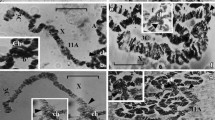Summary
Focuses of the l(1)BP4, vermilion and sevenless genes located in the same band 10A1-2 of Drosophila melanogaster X-chromosome, have been compared. For this purpose first the fate map of the blastoderm for 60 pairs of adult cuticular landmarks has been built based on scoring 612 gynandromorphs. The location of the legs and antenna primordia has been defined more exactly as compared to analogous maps by other authors. The location of new landmarks has been carried out: mesosternal bristle, sex-comb and first tergite primordia. The focus of the l(1)BP4 gene has been determined with the help of this map on the basis of analysis of 321 mosaics. The data obtained show that the lethal focus of the gene belongs to the “bilateral domineering” type and is located in the blastula area giving rise to the nervous system, behind the region of the third thoracic ganglia origin. Beside, there is a pair of autonomous nonlethal focuses of the same gene limited by the wings' zone. The focuses of the l(1)BP4 gene do not coincide with the known focuses of vermilion and sevenless genes, which means that all three genes are active in different tissues.
Similar content being viewed by others
References
Bryant P, Zornetzer M (1973) Mosaic analysis of lethal mutations in Drosophila. Genetics 75:623–637
Garcia-Bellido A, Merriam J (1969) Cell lineage of the imaginal disks in Drosophila gynandromorphs. J Exp Zool 170:61–76
Harris W, Stark W, Walker I (1976) Genetic dissection of the photoreceptor system in the compound eye of Drosophila melanogaster. J Physiol 256:415–439
Hotta Y, Benzer S (1972) Mapping of behaviour in Drosophila mosaics. Nature (Lond) 240:535–564
Janning W (1978) Gynandromorph fate maps in Drosophila. In: Gehring WI (ed) Results and problems in cell differentiation, vol 9, pp 1–35
Kankel D, Hall J (1976) Fate mapping of nervous system and other internal tissues in genetic mosaics of Drosophila melanogaster. Dev Biol 48:1–24
Lindsley D, Grell E (1968) Genetic variation of Drosophila melanogaster. Carnegie Inst Wash Publ 124, 146, 230, 266, 281
Nissani M (1975) Cell lineage analysis of kinurenine producing organs in Drosophila melanogaster. Genet Res Cambr 26:63–72
Ripoll P, Garcia-Bellido A (1973) Cell autonomous lethals in Drosophila melanogaster. Nature New Biol 241:16–17
Zhimulev I, Belyaeva E (1975) Proposals to the problem of structural and functional organization of polytene chromosomes. Theor Appl Genet 45:335–347
Zhimulev I, Pokholkova G, Bgatov A, Semeshin V, Belyaeva E (1981) Fine cytogenetical analysis of the band 10A1-2 and the adjoining regions in the Drosophila melanogaster X-chromosome. II. Genetical analysis. Chromosoma (Berl) 82:25–40
Author information
Authors and Affiliations
Additional information
Communicated by H. Böhme
Rights and permissions
About this article
Cite this article
Bgatov, A.V., Zharkikh, A.A. & Zhimulev, I.F. Fine cytogenetical analysis of the band 10A1-2 and the adjoining regions in the Drosophila melanogaster X chromosome. Mol Gen Genet 196, 110–116 (1984). https://doi.org/10.1007/BF00334101
Received:
Issue Date:
DOI: https://doi.org/10.1007/BF00334101




